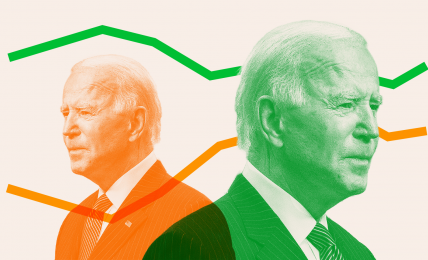© Tony Gutierrez/AP
A makeshift memorial for the victims of the mass killing at a mall in Allen, Tex., seen Wednesday.
Jeremy Hammer was at a crowded college party in Virginia last month when he heard a loud bang. There were gasps, followed by a scream. Then everyone began rushing toward the exits.
Hammer remembers feeling terrified. “It was one of those moments where you’re like, ‘Oh my God, it’s my turn.’” It took a minute to grasp that the noise was not a gunshot, but a burst balloon.
Jen Panos is a mother of three in California. She finds herself noting what her kids are wearing to school. If there is a shooting, she thinks, she needs to be able to identify their bodies. “I walk myself through it: What am I going to do if this comes for us?” she said.
Kat Vargas and her husband, a firefighter, live in Texas. They too have a plan for what to do in the event of a shooting: Vargas would cover their youngest, while her husband would shield their middle son. Their eldest, who is 9, might have to run.
Last weekend, Vargas’s husband was one of the first responders to the attack on a mall in Allen, Tex., that killed eight people. Vargas can’t talk about the shooting without crying, but she is not surprised. “It’s surreal, not shocking,” she said.
Hypervigilance. Numbness. Anxiety. Exhaustion. As the country confronts a fresh string of mass killings — in a mall, in a home, at a bank, a birthday party, a school — the unrelenting violence is exacting a psychological toll.
© Jeffrey McWhorter for The Washington Post
Dellandra Musa reassures her son Elijiah, on Wednesday at the makeshift memorial in Allen, Tex.
Experts say that even people far away from the scene of such events can experience increased stress and anxiety. At the same time, the frequency of mass killings means that in some cases, they are losing their capacity to stun and horrify.
This year alone, the country has witnessed 22 mass killings by gunfire, according to a database maintained by the Associated Press, USA Today and Northeastern University that includes incidents where four or more people were killed, not including the shooter. That represents a marked increase from 2022: At this time last year, there had been eight such events.
While mass killings draw the media spotlight, they are a small fraction of the country’s gun deaths, which include tens of thousands of homicides and suicides each year. Researchers at Boston University concluded that over the course of an American’s lifetime, the likelihood of knowing someone killed or injured by gunfire is nearly 100 percent.
© Johnnie Izquierdo/for The Washington Post
A mourner prays at the makeshift memorial at Nashville’s Covenant School on Monday, a day after the shooting there.
The burden comes atop an already acute sense of emotional exhaustion after a years-long period marked by a deadly pandemic, climate-related disasters and a belated racial reckoning, said Roxane Cohen Silver, a professor of psychology at the University of California at Irvine who studies trauma.
“There’s a broader context here of many years of stress and anxiety and uncontrollable events that have felt really almost too much to bear,” she said.
Silver’s research has shown how media exposure can transmit the psychological impact of traumatic events well beyond their immediate area. One study found that after the 2013 Boston marathon bombing, people who immersed themselves in media coverage of the attack experienced more acute stress than people in Boston.
“When you’re at an event, there is a beginning, middle and end,” Silver said. But when you’re absorbed in the coverage, “you’re seeing a loop over and over again of the tragedy.”
Meghan Alessi, a project manager in Louisville, knows how that feels. When she was 20, she was at a premiere of the movie “The Dark Knight Rises” the same day a shooter opened fire during a showing of the film in Aurora, Colo., killing 12. She became fixated on the coverage, grieving over the victims, learning about their families and trying to find ways to protect herself in the future.
In more recent years, however, she has found herself tuning out the coverage of shootings. It’s a form of self-preservation, she said. The prevalence of such incidents “just leads you to become numb to it,” said Alessi, 30. “It’s such a normal thing at this point that everyone moves on, whether you’re ready to or not.”
When Alessi learned about a mass killing last month at a bank in downtown Louisville, near where her fiance works, she felt panic, followed by a sense of helplessness. At a concert last weekend in Atlanta, Alessi said, she wondered for the first time what she would do if a shooter attacked the event.
Psychologists who study how people respond to tragedies say that feeling powerless can lead to emotional numbness. “If you pay attention and you’re upset and you feel you can’t do anything about it, well, it makes sense to turn it off,” said Paul Slovic, a professor of psychology at the University of Oregon. “Otherwise, you’re in a constant state of agitation and anger.”
Slovic’s research has shown, paradoxically, that the larger the number of victims of a tragedy, the harder it is for people to care. It’s a phenomenon he calls the “deadly arithmetic of compassion.” What’s more, when a problem is presented as something that impacts millions, Slovic’s research has shown that people are less likely to respond because it makes them feel ineffective and discouraged.
“We have more ability to help than we realize, but we get demotivated by thinking we can’t fix this problem,” Slovic said. “But anything we can do matters … even partial solutions can save whole lives.”
Hammer, the college student who felt panicked at the party, said he is so pessimistic about the country’s willingness to change that he has considered moving somewhere with less gun violence. He grew up doing lockdown drills in school. He was in the fourth or fifth grade when he realized they weren’t a fun exercise in hiding.
A man writes a message on a wooden heart during a memorial at Monterey Park City Hall in Monterey Park, Calif., on Tuesday to honor those killed and injured when a gunman opened fire inside a dance studio. (Philip Cheung for The Washington Post)
Now 20 and a student at James Madison University in Harrisonburg, Va., Hammer doesn’t watch the news, but gun violence finds him anyway.
Last year, there was a shooting at nearby Bridgewater College that left two dead. A few weeks ago, there was a shooting at the apartment complex next to where Hammer lives. Two more people dead, in the kind of gun violence so common that it doesn’t make headlines beyond local outlets.
To help pay for college, Hammer works part time at Walmart. Each month, he said, employees are required to watch a training video on what to do in the event of an active shooter. In November, a gunman killed six fellow employees at a Walmart in Chesapeake, Va.
Hammer said he feels both numb and much more aware of his surroundings, always alert to the potential for violence. “I’m so exhausted wondering if I’m next,” he said.
Jocelyn R. Smith Lee, a professor at the University of North Carolina Greensboro who studies gun violence and racial trauma, said the nation is now “wrestling with things that communities of color have been tasked with navigating for centuries.”
© Mike Caudill for The Washington Post
Trisha Mathews on Nov. 25, 2022, signs a personal message for one of the victims of the Walmart mass killing in Chesapeake, Va.
“If gun violence is a threat to your daily life, there is no place you go that you’re not taking stock of safety,” Smith Lee said. The whole country is now being forced to weigh risks that are familiar to communities that have been disproportionately impacted by fatal shootings, she said. And the toll of frequent tragic events, overwhelming to many, “can be uniquely burdensome for people of color.”
Panos, the mother of three, said she and her husband adjusted their behavior years ago. They live in Upland, Calif., east of Los Angeles, and when they go to a restaurant, one of them faces each door to observe who is entering. They have told their children that if anything bad happens at school, they should run away bent over, protecting their upper bodies.
Panos, 45, can feel herself shutting down when news of another mass killing emerges. “If I allow myself to spiral into the anxiety, the fear, the rage, the frustration, I cease to be useful,” she said. Her brother used to live in the Dallas suburb where Saturday’s attack took place. Her parents have shopped at that mall. “You keep thinking, it is getting closer and closer to being my turn,” she said.
Ron Acierno is a professor of psychiatry at the University of Texas Health Science Center at Houston and director of its center on trauma and resilience. He said he sees in his daily work the ways that people are growing more numb to mass killings. “They say things like, ‘Which school shooting was that again?’” Acierno said.
Desensitization is an understandable response, he said. But it doesn’t make us safer, unlike powerful emotions that can “drive you to act,” Acierno said.
“Horror is an appropriate response to a kid being shot in a mall, in a school, at home. It’s a horrible thing that you should feel horrible about until you’ve done something to make the situation better,” he said.
For Vargas, the mother in Texas, that moment of awful clarity came in 2019 when a shooter killed 23 people at a Walmart in El Paso. At the time, she and her husband had two boys. As they lay in bed that night, they began talking about who was going to cover which child if there was a shooting.
“Something just broke,” said Vargas, 31. She told her husband, “This is not rational. We cannot live this way.”
Vargas began volunteering with Moms Demand Action, a group dedicated to strengthening gun laws to reduce violence. She began voting for Democrats instead of Republicans.
Last year, her husband took part in a multiday active shooter simulation drill. When he came home, he sat on their sofa and cried, she said. We are training not to prevent shootings, he told her, but to arrive to dead bodies and treat those lucky enough to live. On May 6, he responded in real life.
Vargas thought about the parents who died trying to shield children from a hail of bullets in two mass killings in Texas in recent days. Her voice shook with sorrow and rage.
“This is hell,” she said. “Enough is enough.”
© Scott Olson/Getty Images
People visit a makeshift memorial near Club Q on Monday in Colorado Springs. On Saturday evening, a 22-year-old gunman entered the LGBTQ nightclub and opened fire, killing five people and injuring 25 others before being stopped by club patrons.
Justine McDaniel contributed to this report.


